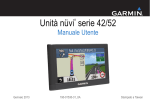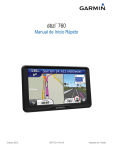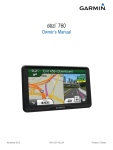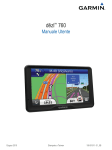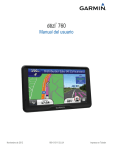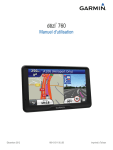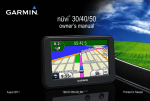Download Auto Page EXP-52 Owner`s manual
Transcript
nüvi 42/52 Series ® Owner’s Manual December 2012 190-01530-00_0A Printed in Taiwan © 2012 Garmin Ltd. or its subsidiaries All rights reserved. Except as expressly provided herein, no part of this manual may be reproduced, copied, transmitted, disseminated, downloaded or stored in any storage medium, for any purpose without the express prior written consent of Garmin. Garmin hereby grants permission to download a single copy of this manual onto a hard drive or other electronic storage medium to be viewed and to print one copy of this manual or of any revision hereto, provided that such electronic or printed copy of this manual must contain the complete text of this copyright notice and provided further that any unauthorized commercial distribution of this manual or any revision hereto is strictly prohibited. Information in this document is subject to change without notice. Garmin reserves the right to change or improve its products and to make changes in the content without obligation to notify any person or organization of such changes or improvements. Go to the Garmin Web site (www.garmin.com) for current updates and supplemental information concerning the use and operation of this and other Garmin products. Garmin®, the Garmin logo, MapSource® and nüvi® are trademarks of Garmin Ltd. or its subsidiaries, registered in the USA and other countries. nüMaps Guarantee™ and nüMaps Lifetime™ are trademarks of Garmin Ltd. or its subsidiaries. These trademarks may not be used without the express permission of Garmin. Windows® is a registered trademarks of Microsoft Corporation in the United States and/or other countries. Mac® is a registered trademark of Apple Computer, Inc. Table of Contents Getting Started����������������������������������������� 1 Mounting the Device������������������������������������������ 1 About myDashboard������������������������������������������ 2 About Garmin Express�������������������������������������� 3 Turning Off the Device��������������������������������������� 4 Finding Locations������������������������������������ 5 About Points of Interest������������������������������������� 6 Saving a Home Location����������������������������������� 7 Location Searches��������������������������������������������� 7 Using the Location Map������������������������������������� 9 Favorites���������������������������������������������������������� 10 Map Pages���������������������������������������������� 12 Following an Automobile Route����������������������� 12 Map Pages������������������������������������������������������ 13 Data Management���������������������������������� 15 File Types�������������������������������������������������������� 16 About Memory Cards��������������������������������������� 16 Transferring Files from Your Computer ���������� 16 Deleting Files �������������������������������������������������� 17 Customizing the Device������������������������ 17 System Settings����������������������������������������������� 17 Navigation Settings������������������������������������������ 18 Display Settings����������������������������������������������� 18 Time Settings��������������������������������������������������� 18 Language Settings������������������������������������������� 19 Map Settings���������������������������������������������������� 19 Proximity Points Settings��������������������������������� 20 Restoring Settings������������������������������������������� 20 Appendix������������������������������������������������ 20 Caring for Your Device������������������������������������� 20 Erasing User Data������������������������������������������� 21 Changing the Fuse in the Vehicle Power Cable��������������������������������������������������������������� 22 Removing Suction Cup Mount from the Windshield������������������������������������������������������� 22 About nüMaps Lifetime ����������������������������������� 22 Safety Cameras����������������������������������������������� 23 Purchasing Accessories���������������������������������� 23 Contacting Garmin Product Support���������������� 23 Troubleshooting ���������������������������������������������� 24 Getting Started ‹ WARNING ee the Important Safety and Product S Information guide in the product box for product warnings and other important information. 1 Connect the device to vehicle power (page 1). 2 Mount the device (page 1). 3 Register the device (page 3). 4 Check for updates. • Software updates (page 3). • Free map update (page 3). Getting Started Mounting the Device ‹ WARNING This product contains a lithium-ion battery. To prevent the possibility of personal injury or product damage caused by battery exposure to extreme heat, remove the device from the vehicle when exiting or store it out of direct sunlight. Notice Before mounting the device, see the Important Safety and Product Information guide for information about laws pertaining to windshield mounting. 1 Charge your device as you drive before using it on battery power. 1 Press the suction cup ➊ to the windshield. ➋ ➏ ➎ ➍ 2 While pressing, flip the lever ➋ back toward the windshield. 3 Press the mount ➌ up and into the opening on the back of the device until it snaps into place. 4 Plug the vehicle power cable ➍ into the USB port ➎ on the device. 2 cable into a power outlet in your vehicle. 6 Snap the mount onto the suction cup ➏ arm. Acquiring Satellites ➌ ➊ 5 Plug the other end of the vehicle power The device may require an open view of the sky to acquire satellite signals. When the bars are green, the device has acquired satellite signals. About myDashboard Use myDashboard to register your device, check for software and map updates, access product manuals and support, and more. Getting Started About Garmin Express Use Garmin Express to register your device, check for software and map updates, access product manuals and support, and more. Setting Up Garmin Express 1 Connect a USB cable ➊ to the mini-USB port ➋ on the device. ➊ ➋ 2 Connect the other end of the USB cable to the USB port on your computer. 3 Go to www.garmin.com/express. Getting Started 4 Follow the on-screen instructions. nüMaps Guarantee™ If you register the device at www.garmin.com /express within 90 days of acquiring satellites while driving, your device could be eligible for one free map update. Go to www.garmin.com /numaps for terms and conditions. Updating Maps 1 Register the device (page 3). 2 Under Map Updates, click Update Now. 3 Follow the on-screen instructions. Activating Lifetime Maps 1 Go to www.garmin.com/lifetimeupdater. 2 Follow the on-screen instructions. NOTE: If you register the device, you can receive e-mail notifications when a map update is available. 3 Turning Off the Device 1 Tap the Power key ➊. ➊ 2 Select Power Off. or . • Select • Select the Mute check box. Status Bar Icons The status bar is located at the top of the main menu. The status bar icons display information about features on the device. You can select some icons to change settings or view additional information. GPS signal status. Resetting the Device Current time. You can reset your device if it stops functioning. Hold the Power key for 10 seconds. Battery status. Changing the Screen Brightness 1 Select Settings > Display > Brightness. or . 2 Select Using Help Adjusting the Volume 1 Select Volume. 2 Select an option: Searching Help Topics Select > Search. 4 Select to view information about using the device. Getting Started Using the On-Screen Buttons • Hold to quickly return to the main menu. • Select and to see more choices. • Select and hold and to scroll faster. Using the On-Screen Keyboard See “System Settings” to change the keyboard layout (page 17). 1 Select Where To? > Points of Interest > Spell Name. 2 Select an option. • Select a character on the keyboard to enter a letter or number. • Select to add a space. • Select to change the character case. • Select and to move the cursor. • Select to delete a character. Finding Locations to erase the entire • Select and hold entry. • Select Mode to select the keyboard language mode. • Select to enter special characters, such as punctuation marks. Finding Locations There are many ways to find locations. • By category (page 6) • Near another location (page 6) • By spelling the name (page 7) • By address (page 8) • Using recently found locations (page 8) • Using coordinates (page 9) • Using the map (page 9) • Using Favorites (page 10) 5 About Points of Interest The detailed maps loaded in your device contain points of interest, such as restaurants, hotels, and auto services. Finding a Point of Interest by Category 1 Select Where To? > Points of Interest. 2 Select a category. 3 If necessary, select a subcategory. 4 Select a location. 5 Select Go!. Searching Within a Category To narrow your search results, you can search within some categories. 1 Select Where To? > Points of Interest. 2 Select a category. 3 If necessary, select a subcategory. 4 Select Spell. 6 5 Enter all or part of the name. 6 Select Done. Searching Near Another Location By default, your device finds locations closest to your current location. You can find a location near another city or location. 1 Select Where To? > Near. 2 Select an option, and select OK. 3 If necessary, select a location. Adding a Stop to a Route 1 While navigating an automobile route, select Where To?. 2 Search for the location (page 6). 3 Select Go!. 4 Select Add as a Via Point. Finding Locations Saving a Home Location You can set your home location for the location you return to most often. 1 Select Where To? > Go Home. 2 Select Enter My Address, Use My Current Location, or Choose from Recently Found. The location is saved as “Home” in Favorites (page 10). Going Home Select Where To? > Go Home. Deleting Your Home Location 1 Select Where To? > Favorites > Home. 2 Select the information balloon. 3 Select Delete, and select Yes. Editing Your Home Location Information 1 Select Where To? > Favorites > Home. Finding Locations 2 3 4 5 Select the information balloon. Select Edit. Enter your changes. Select Done. Location Searches You can search for locations by using the onscreen keyboard, entering the location’s address or coordinates, browsing the map, and more. Finding a Location by Spelling the Name 1 Select Where To? > Points of Interest > Spell Name. 2 Enter a business name or a type of business. For example, you can enter “Starbucks” or “Coffee.” 3 Select Done. 4 Select a location. 7 Finding an Address NOTE: The order of the steps may change depending on the map data loaded on your device. 1 Select Where To? > Address. 2 If necessary, change the state, the country, or the province. 3 Select an option: • Select Spell City, enter the city, and select Done. • Select Search All to search all cities in the state or province. 4 Enter the address number, and select Done. 5 Enter the street name, and select Done. 6 If necessary, select the street. 7 If necessary, select the address. 8 Finding a Location by Browsing the Map 1 Select Where To? > Browse Map. 2 Drag the map to find the location. 3 Select the location. An information balloon appears for the location. 4 Select the information balloon. Viewing a List of Recently Found Locations Your device stores the last 50 locations you have found. Select Where To? > Recently Found. Clearing the List of Recently Found Places Select Where To? > Recently Found > Clear. Finding Locations Finding a Location Using Coordinates You can find a location using latitude and longitude coordinates. This method can be helpful when geocaching. 1 Select Where To? > Coordinates. 2 If necessary, select Format, select the correct coordinate format for the type of map you are using, and select OK. 3 Select the latitude coordinate. 4 Enter the new coordinate, and select Done. 5 Select the longitude coordinate. 6 Enter the new coordinate, and select Done. 7 Select Next. 8 Select Go!. Finding Locations Using the Location Map The location map appears after you select a location from the Where To? menu. ➊ ➍ ➎ ➌ ➋ ➏ ➐ • Select ➊ to save the location to your Favorites. • Select the information balloon ➋ to view more information for the location. • Select ➌ to zoom in and out. • Select ➍ to create a turn-by-turn route to this location. • Select ➎ to return to the previous page. • Select ➏ to set a simulated location (page 10). 9 • Select ➐ to view different parts of the map. Setting a Simulated Location If you are indoors or not receiving satellite signals, you can use the GPS simulator to set a simulated location. 1 Select Settings > System. 2 Select GPS Simulator > On > OK. 3 From the main menu, select Where To? > Browse Map. 4 Select an area on the map. An information balloon appears for the location. 5 Select Set Location. Favorites You can save locations in your Favorites so you can quickly find them and create routes to them. Your home location is also stored in Favorites. 10 Saving Your Location to Favorites 1 From the map, select the vehicle icon. 2 Select Save Location. 3 Enter a name, and select Done. 4 Select OK. The location is saved in Favorites. Saving Locations to Favorites 1 Search for the location (page 6). 2 From the location map, select Save > OK. Finding Favorites 1 Select Where To? > Favorites. 2 If necessary, select a category. 3 Select a saved location. Editing Favorites 1 Select Where To? > Favorites. 2 If necessary, select a category. Finding Locations 3 4 5 6 Select a Favorite. Select the information balloon. Select Edit. Select an option: • Select Change Name. • To change the symbol used to mark the Favorite on a map, select Change Map Symbol. • Select Change Phone Number. • To assign categories to the Favorite, select Change Categories. 7 Edit the information. 8 Select Done. 1 2 3 4 5 Select Where To? > Favorites. Select the Favorite. Select the information balloon. Select Edit > Change Categories. Select New. Deleting Favorites NOTE: Deleted Favorites cannot be recovered. 1 Select Where To? > Favorites. 2 If necessary, select a category. 3 Select the Favorite. 4 Select the information balloon. 5 Select Delete > Yes. Adding a Category You can add custom categories to organize your Favorites. NOTE: Categories appear in the Favorites menu after you have saved more than 12 Favorites. Finding Locations 11 Map Pages An icon displaying the current speed limit may appear as you travel on major roadways. Following an Automobile Route notice The speed limit icon feature is for information only and does not replace the driver’s responsibility to abide by all posted speed limit signs and to use safe driving judgment at all times. Garmin will not be responsible for any traffic fines or citations that you may receive for failing to follow all applicable traffic laws and signs. The route is marked with a magenta line. A checkered flag marks your destination. As you travel, the device guides you to the destination with voice prompts, arrows on the map, and directions at the top of the map. If you depart from the original route, the device recalculates the route and provides new directions. 12 Taking a Detour While navigating a route, you can use detours to avoid obstacles ahead of you, such as construction zones. NOTE: If the route you are currently taking is the only reasonable option, the device might not calculate a detour. 1 While navigating a route, select to return to the main menu. 2 Select Detour. Map Pages Stopping the Route While navigating a route, select Navigating Off Road > Stop. You can create straight-line routes that do not follow roadways. 1 Select Settings > Navigation. 2 Select Route Preference > Off Road > OK. The route will be calculated as a straight line to the location. Changing the Map Data Field 1 From the map, select a data field. 2 Select a type of data to display. 3 Select OK. Map Pages Viewing Current Location Information Use the Where Am I? page to view information about your current location. This is helpful if you need to tell emergency personnel your location. From the map, select the vehicle icon. Finding Nearby Services 1 From the map, select the vehicle icon. 2 Select Hospitals, Police Stations, or Fuel to view the nearest locations in that category. Map Pages Viewing Trip Information The trip information page displays your present speed and provides statistics about your trip. TIP: If you make frequent stops, leave the device turned on so it can accurately measure elapsed time during the trip. From the map, select the Speed field. 13 Resetting Trip Information 1 From the map, select the Speed field > Reset. 2 Select an option: • Select Reset Trip Data to reset the information on the trip computer. • Select Reset Max. Speed to reset the maximum speed. Select OK. 3 Viewing a List of Turns When you are navigating a route, you can view all of the turns and maneuvers for your entire route and the distance between turns. 1 Select the text bar on the top of the map. 14 2 Select a turn. The details for the turn appear. If available, an image of the junction appears for junctions on major roadways. Viewing the Entire Route on the Map 1 While navigating an automobile route, select the navigation bar at the top of the map. 2 Select Show Map. Map Pages Viewing the Next Turn While navigating an automobile route, a preview of the next turn, lane change, or other maneuver appears in the upper-left corner of the map. The preview includes the distance to the turn or maneuver and the lane in which you should be traveling, if available. From the map, select . Viewing an Upcoming Junction While navigating an automobile route, you can view the junctions on major roadways. When you approach a junction in a route, the image of that junction appears briefly, if available. . 1 From the map, select Data Management 2 Select Junction View. Data Management You can store files, such as JPEG image files, on your device. The device has a memory card slot for additional data storage. NOTE: The device is not compatible with Windows® 95, 98, Me, Windows NT®, and Mac® OS 10.3 and earlier. 15 File Types The device supports the following file types: • Maps and GPX waypoint files from MapSource® • GPI custom POI files from Garmin POI Loader. About Memory Cards You can purchase memory cards from an electronics supplier, or purchase pre-loaded Garmin mapping software (www.garmin.com /trip_planning). In addition to map and data storage, the memory card can be used to store files such as maps, images, geocaches, routes, waypoints, and custom POIs. Installing a Memory Card The device supports microSD™ and microSDHC memory or data cards. 16 Insert a memory card into the slot on the device. Transferring Files from Your Computer 1 Connect the device to your computer (page 3). Your device and memory card appear as removable drives in My Computer in Windows and as mounted volumes on Mac computers. NOTE: Some computers with multiple network drives cannot display nüvi drives. See your operating system Help file to learn how to map the drives. 2 On your computer, open the file browser. 3 Select the file. 4 Select Edit > Copy. Data Management 5 Open the Garmin or memory card drive or volume. 6 Select Edit > Paste. The file appears in the list of files in the device memory or on the memory card. Disconnecting the USB Cable 1 Complete an action: • For Windows computers, click the eject icon in your system tray. • For Mac computers, drag the volume icon to the Trash . 2 Disconnect the cable from your computer. Deleting Files NOTICE If you do not know the purpose of a file, do not delete it. Your device memory contains important system files that should not be deleted. Customzing the Device 1 2 3 4 Open the Garmin drive or volume. If necessary, open a folder or volume. Select the file. Press the Delete key on your keyboard. Customizing the Device 1 Select Settings. 2 Select a setting category. 3 Select the setting to change it. System Settings Select Settings > System. • GPS Simulator—stops the device from receiving a GPS signal, and saves battery power. • Units—sets the unit of measure used for distances. 17 • Keyboard Layout—sets the keyboard layout. • Safe Mode— disables all functions that require significant operator attention and could become a distraction while driving. • About—displays the nüvi software version number, the unit ID number, and information about several other software features. You need this information when you update the system software or purchase additional map data. Navigation Settings Select Settings > Navigation. • Route Preference—select a preference for calculating your route. • Avoidances—select the road types you want to avoid on your routes. 18 Display Settings Select Settings > Display. • Color Mode—sets a light background (Day), a dark background (Night), or automatically switches between the two based on the sunrise time and the sunset time for your current location (Auto). • Screenshot—allows you to take a picture of the device screen. Screenshots are saved in the Screenshot folder of the device storage. • Brightness—changes the brightness of the screen. Decreasing the brightness can save battery power. Time Settings Select Settings > Time. • Time Format—select a 12-hour, 24-hour, or UTC time format. Customzing the Device • Current Time—manually set the time on your nüvi. Select Automatic to have the device set the time based on your location. Language Settings Select Settings > Language. • Voice Language—sets the language for voice prompts. • Text Language—sets all on-screen text to the selected language. NOTE: Changing the text language does not change the language of user-entered data or map data, such as street names. • Keyboard—sets the language for your keyboard. Map Settings Select Settings > Map. Customzing the Device • Map Detail—adjusts the amount of detail shown on the map. Showing more detail can cause the map to redraw slower. • Map View—sets a map perspective. ◦◦ Track Up—displays the map in two dimensions (2D) with your direction of travel at the top. ◦◦ North Up—displays the map in 2D with North at the top. ◦◦ 3D—displays the map in three dimensions (3D) in Track Up. • Vehicle—select Change to change the icon used to display your position on the map. Download additional vehicle icons at www .garmingarage.com. • Trip Log—shows or hides the log of your travels. • Map Data Layout—changes the amount of data visible on the map. 19 • Info—view the maps and the version of each map loaded on your nüvi. Select a map to enable or disable that map. TIP: To purchase additional map products, go to www.garmin.com/us/maps. Proximity Points Settings Select Settings > Proximity Points. • Alerts—notifies you when you approach custom safety cameras (page 23). See www.garmin.com/safetycamera for more information. Restoring Settings You can restore a category of settings or all settings to the factory defaults. 1 Select Settings. 2 If necessary, select a settings category. 3 Select Restore. 20 Appendix Caring for Your Device notice Avoid dropping your device and operating it in high-shock and high-vibration environments. Do not expose the device to water. Contact with water can cause this device to malfunction. Do not store the device where prolonged exposure to extreme temperatures can occur, because it can cause permanent damage. Never use a hard or sharp object to operate the touchscreen, or damage may result. Appendix Cleaning the Outer Casing notice Avoid chemical cleaners and solvents that can damage plastic components. 1 Clean the outer casing of the device (not the touchscreen) using a cloth dampened with a mild detergent solution. 2 Wipe the device dry. Cleaning the Touchscreen 1 Use a soft, clean, lint-free cloth. 2 If necessary, use water, isopropyl alcohol, or eyeglass lens cleaner. 3 Apply the liquid to the cloth. 4 Gently wipe the screen with the cloth. Avoiding Theft • Remove the device and mount from sight when not in use. Appendix • Remove the residue left on the windshield by the suction cup. • Do not keep your unit in the glove compartment. • Register your device at http://my.garmin .com. Erasing User Data 1 Turn the device on. 2 Hold your finger on the lower-right corner of the device screen. 3 Keep your finger pressed until the pop-up window appears. 4 Select Yes to clear all user data. All original settings are restored. Any items that you have saved are erased. Extending the Battery Life • Keep your device away from extreme temperatures. 21 • Decrease the screen brightness (page 4). • Do not leave your device in direct sunlight. • Decrease the volume (page 4). Changing the Fuse in the Vehicle Power Cable notice When replacing the fuse, do not lose any of the small pieces and make sure they are put back in the proper position. The vehicle power cable does not work unless it is assembled correctly. If your device does not charge in your vehicle, you may need to replace the fuse located at the tip of the vehicle adapter. 1 Unscrew the end piece. TIP: You may need to use a coin to remove the end piece. 2 Remove the end piece, the metal tip, and the fuse (glass and metal cylinder). 22 3 Install a 1 A fast-blow fuse. 4 Place the metal tip in the end piece. 5 Screw the end piece back into the vehicle power cable. Removing Suction Cup Mount from the Windshield Removing the Suction Cup Mount from the Windshield 1 Flip the lever on the suction cup mount toward you. 2 Pull the tab on the suction cup toward you. About nüMaps Lifetime For a one-time payment, you can receive up to four map updates each year for the life of your device. For more information on nüMaps Lifetime and complete terms and conditions, Appendix go to www.garmin.com, and click Maps & Accessories. Purchasing Accessories Safety Cameras Contacting Garmin Product Support ‹ Caution Garmin is not responsible for the accuracy of, or the consequences of using, a custom POI or safety camera database. Safety camera information is available in some locations. Check www.garmin.com/safetycamera for availability. For these locations, the nüvi includes the locations of hundreds of safety cameras. Your nüvi alerts you when you are approaching a safety camera and can warn you if you are driving too fast. The data is updated at least weekly, so you always have access to the most up-to-date information. You can purchase a new region or extend an existing subscription at any time. Each region that you purchase has an expiration date. Appendix Go to http://buy.garmin.com. You can contact Garmin Product Support if you have any questions about this product. • Go to www.garmin.com/support. • In the USA, call (913) 397.8200 or 1-800-800-1020. • In the UK, call 0808 2380000. • In Europe, call +44 (0) 870.8501241. 23 Troubleshooting Problem Solution My device is not acquiring • Select Settings > System > GPS Simulator > Off. satellite signals • Make sure your device is out of parking garages and away from tall buildings and trees. • Remain stationary for several minutes. The suction cup will not • Clean the suction cup and windshield with rubbing alcohol. stay on my windshield. • Dry with a clean, dry cloth. • Mount the suction cup (page 1). The device does not • Check the fuse in the vehicle power cable (page 22). charge in my vehicle. • Verify the vehicle is turned on and is supplying power to the power outlet. • Your device can only charge between 32° and 113°F (between 0° and 45°C). If the device is placed in direct sunlight or in a hot environment, it cannot charge. My battery does not stay To maximize the time between charges, turn down the backlight (page 18). charged for very long. My battery gauge does not Allow the unit to fully discharge, and fully charge it (without interrupting the charge seem accurate. cycle). How do I know my device When your device is in USB mass storage mode, a picture of a device connected is in USB mass storage to a computer is shown on the device screen. Also, you should see one or two new mode? removable disk drives listed in My Computer. 24 Appendix The device is connected to the computer, but it will not go into mass storage mode. 1 Disconnect the USB cable from your computer. 2 Turn off the device. 3 Plug the USB cable into a USB port on your computer and into your device. The device automatically turns on and goes into USB mass storage mode. 4 Verify your device is connected to a USB port and not a USB hub. If you have several network drives mapped on your computer, Windows can have I cannot see any new removable drives in my list trouble assigning drive letters to your device drives. Refer to your operating system of drives. Help file to learn how to map or assign drive letters. Appendix 25 www.garmin.com/support 913-397-8200 1-800-800-1020 0808 238 0000 +44 870 850 1242 1-866-429-9296 43 (0) 3133 3181 0 00 32 2 672 52 54 00 45 4810 5050 00 358 9 6937 9758 00 331 55 69 33 99 0180 5 / 42 76 46 - 880 00 39 02 3669 9699 0800-0233937 815 69 555 00800 4412 454 +44 2380 662 915 00 35 1214 447 460 00 34 902 007 097 00 46 7744 52020 Garmin International, Inc 1200 East 151st Street, Olathe, Kansas 66062, USA Garmin (Europe) Ltd. Liberty House, Hounsdown Business Park Southampton, Hampshire, SO40 9LR UK Garmin Corporation No. 68, Zhangshu 2nd Road, Xizhi Dist. New Taipei City, 221, Taiwan (R.O.C.) Garmin®, the Garmin logo, and MapSource® are trademarks of Garmin Ltd. or its subsidiaries, registered in the USA and other countries. nüMaps Guarantee™, and nüMaps Lifetime™ are trademarks of Garmin Ltd. or its subsidiaries. These trademarks may not be used without the express permission of Garmin. Windows® is a registered trademarks of Microsoft Corporation in the United States and/or other countries. Mac® is a registered trademark of Apple Computer, Inc. microSD™ is a trademark of SD-3C, LLC. TA-2012/1346 TA-2012/1347 © 2012 Garmin Ltd. or its subsidiaries
































